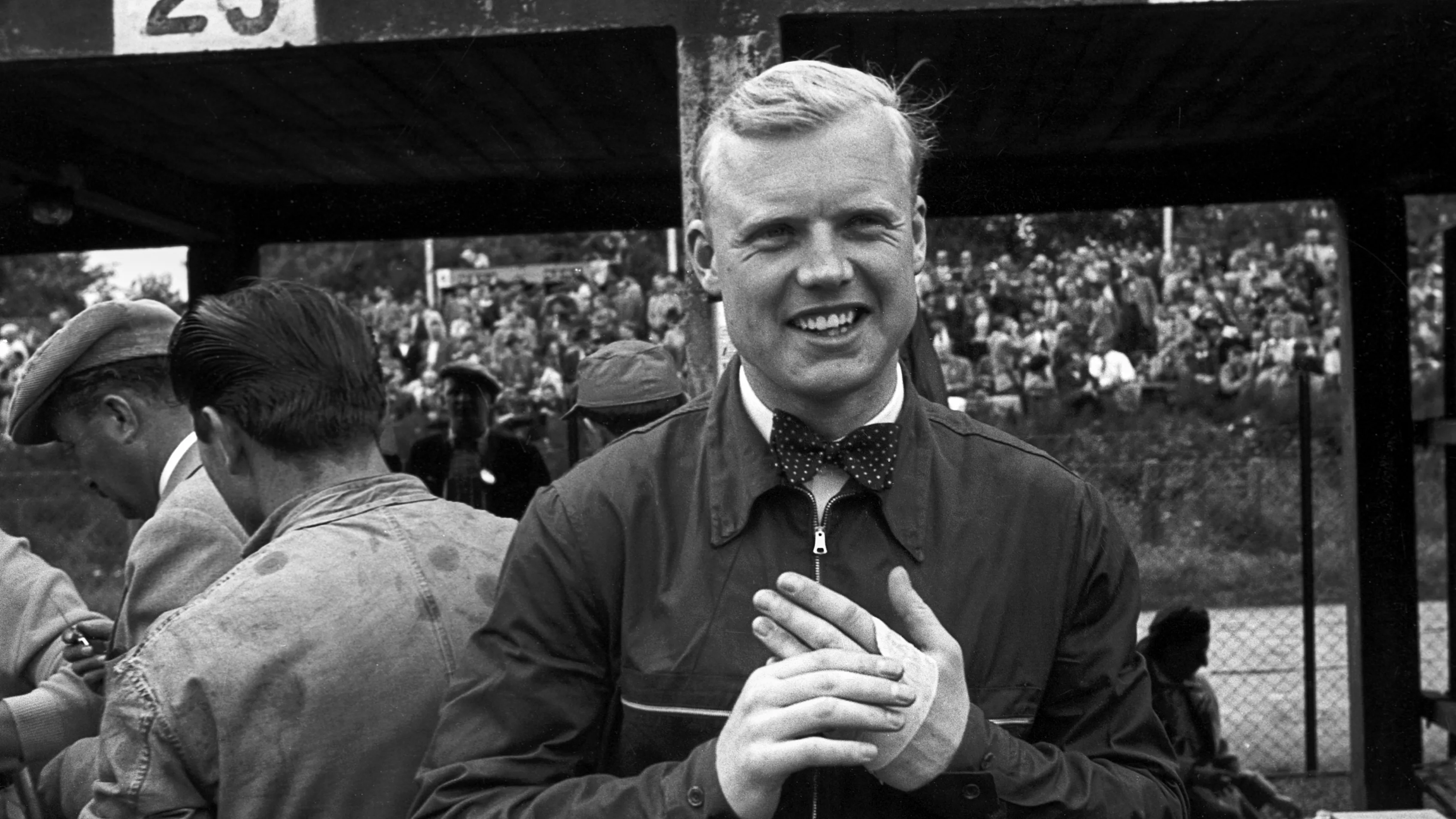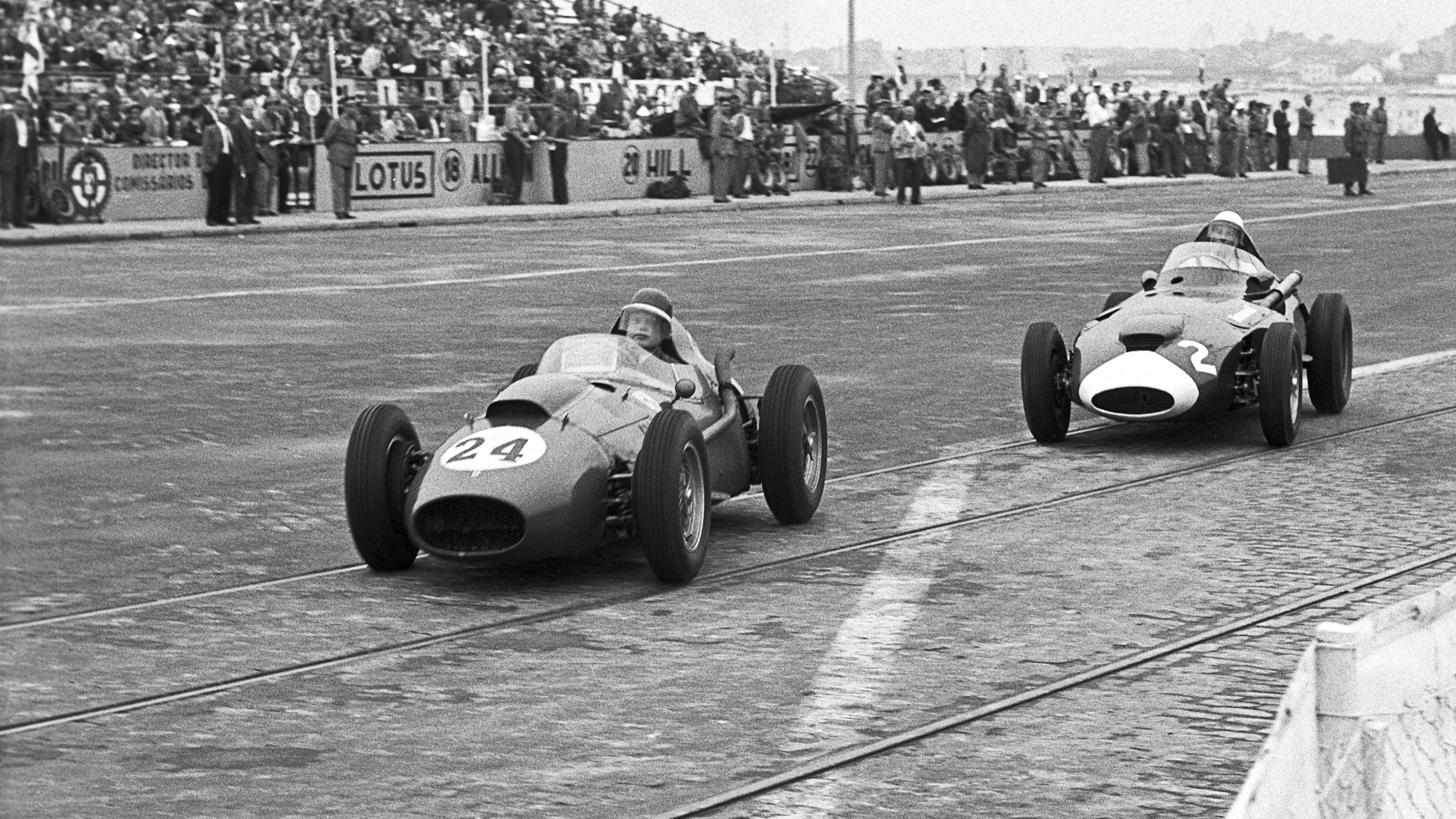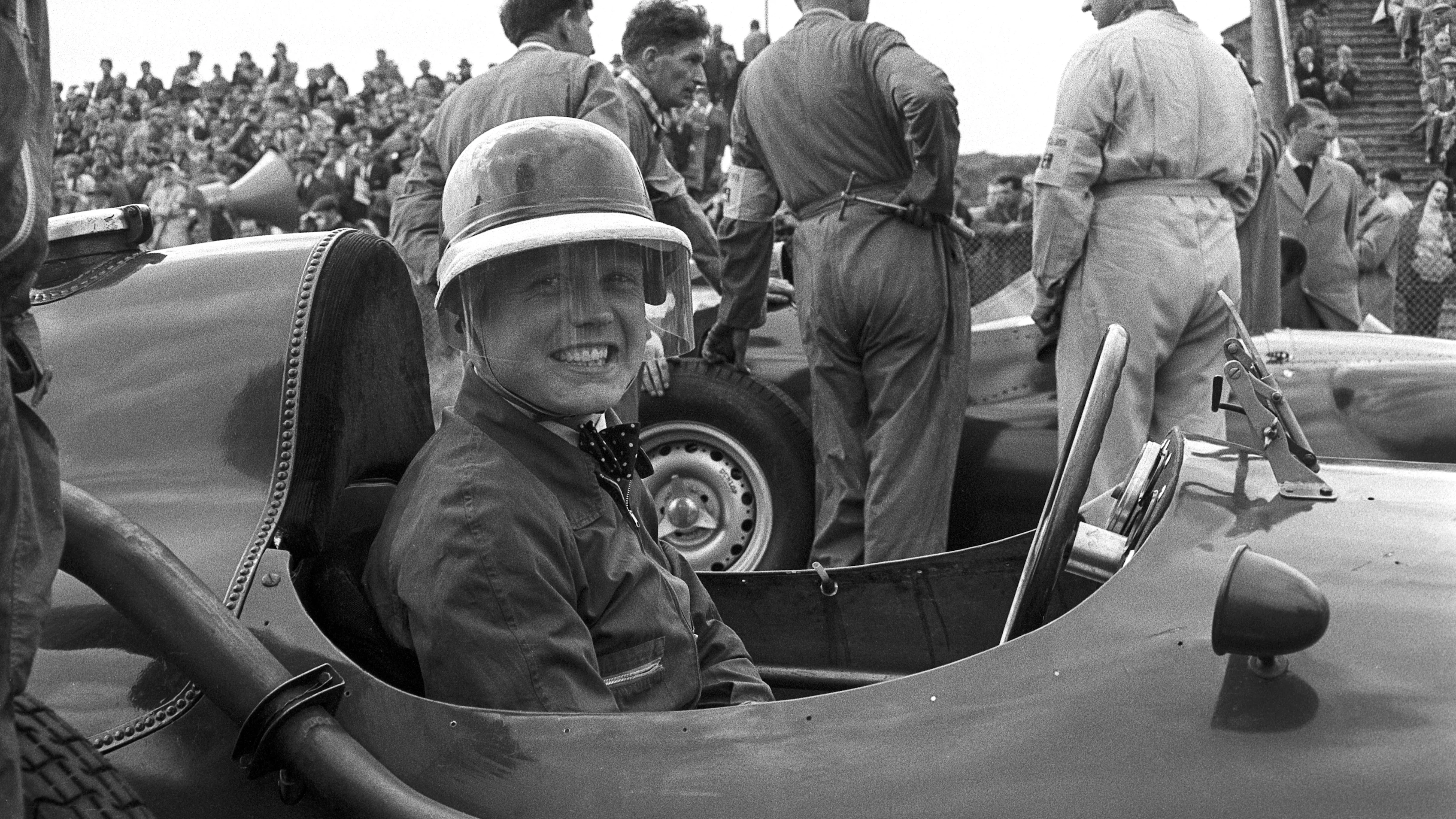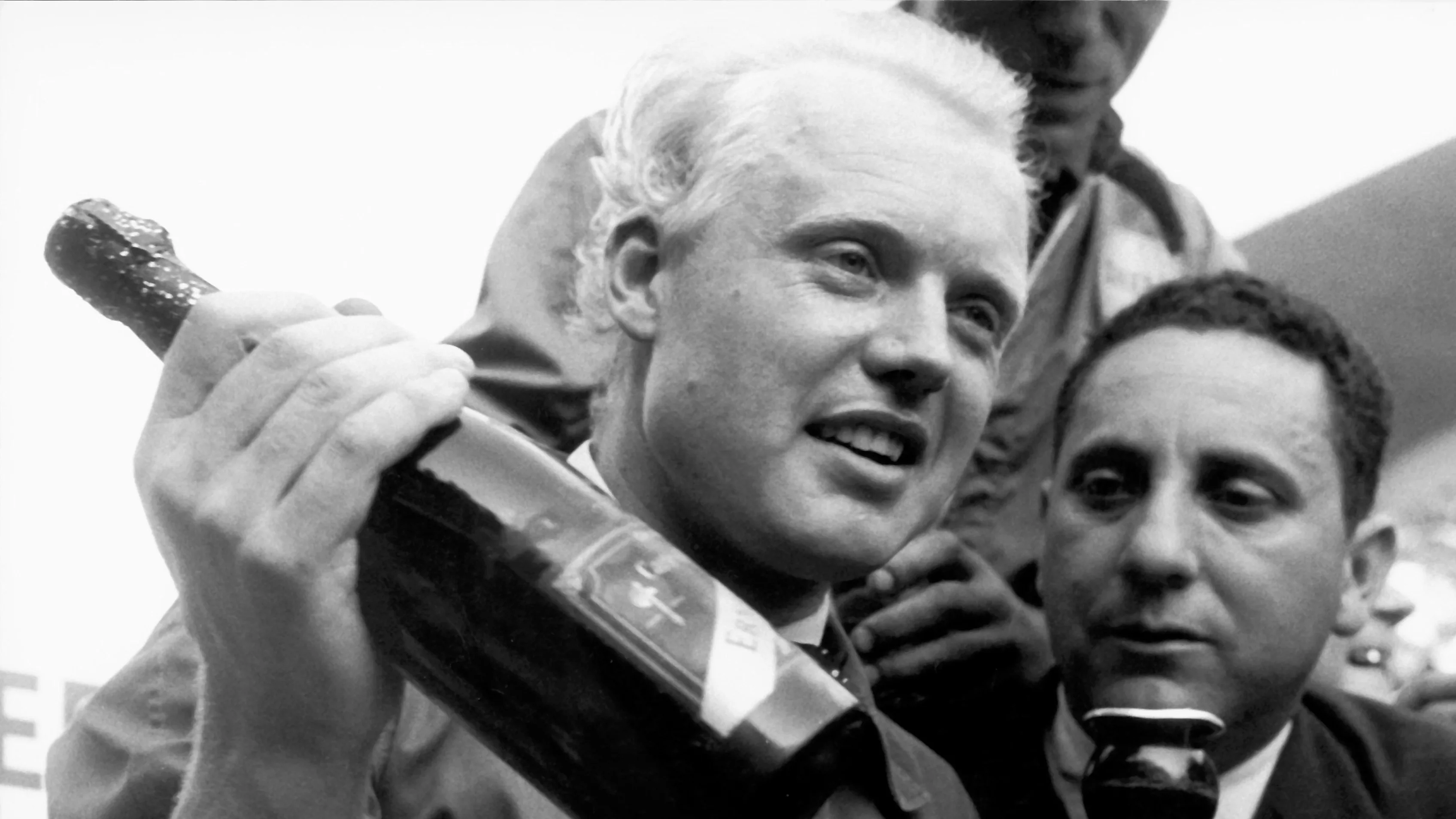HALL OF FAME - 1958
Mike Hawthorn

Mike Hawthorn loved life, drove fast and died young. Big, blond and boisterous, he often raced wearing a broad grin and a bow tie. He regarded motorsport as a quick way to further the fun he constantly pursued. When his pastime became a profession he partied as hard as he drove, though his career was also tinged by tragedy, scandal and personal misfortune. Near the end he found Formula 1 racing no fun at all, but he went out a winner. Other champions were greater drivers but none was a more colourful personality.
Had he been born a decade earlier John Michael Hawthorn might have been a heroic Spitfire pilot in the Battle of Britain. Instead, the circumstances in his formative years led him into motorsport and he became Britain's first world driving champion. Two year's after Mike's birth on April 10, 1929, his racing enthusiast father Leslie bought a garage near the Brooklands circuit in Farnham, Surrey, where he had raced motorcycles prior to World War II. Inspired by the proximity of Brooklands, and by the atmosphere in the Hawthorn garage where cars and motorcycles were prepared for competition, Mike was only nine years old when he decided he wanted to become a racer.

His education, at a prominent Public School followed by studies at Chelsea technical college and an apprenticeship with a commercial vehicle manufacturer, was intended to prepare him for a career at the Farnham garage. Meanwhile, his father also encouraged Mike's interest in motorsport, providing him with motorcycles, then cars for local competitions. Mike also sped around the countryside as the ringleader of a group of hell-raising friends searching for girls and pints of beer in pubs. In 1950 he began winning races in a small Riley sportscar bought for him by his father. Three years later the 'Farnham Flyer' was driving a Formula 1 car for Enzo Ferrari.
Mike's meteoric rise from club racer to Grand Prix driver took place within one momentous afternoon at the 1952 Easter Meeting at the Goodwood circuit. It was his first competition in a single-seater, a Formula 2 Cooper-Bristol provided for him by a family friend, and the opposition included the famous Argentine drivers Juan Manuel Fangio and Froilan Gonzalez. Mike won the F2 race from pole position, then also finished first in the Formula Libre race and was a sensational second in the main event, for Formula 1 cars.
Impressive results aside, the Farnham Flyer was a commanding figure in the spindly little Cooper, with the top half of his 6 foot 2 inch (188 centimetre) frame towering above the cramped cockpit, elbows flailing in the wind, head thrust forward, chin first. Prior to Goodwood he had always raced in his everyday clothes, usually a sports jacket and a tie, which at speed tended to flap in his face. For his single-seater debut Mike bought white overalls and wore the bow tie that became his trademark.
Inspired by his splendid showing at Goodwood, Mike and his father decided to enter the Cooper in the remaining races of a 1952 Formula 1 season that was being dominated by Alberto Ascari in a Ferrari. A fourth place in Belgium, a third in Britain and another fourth in Holland left Mike an astonishing fourth overall in the standings. Enzo Ferrari was impressed and hired him for 1953.

His only championship victory in his first Formula 1 season was a singular feat that became the highlight of Mike's career. In a classic 1953 French Grand Prix at Reims his Ferrari crossed the finish line a hair's breadth ahead of the Maserati driven by the great Fangio. On the podium, when he heard God Save The Queen being played Mike burst into tears and was warmly embraced by the ever-gallant Fangio, who thought him: "a nice young fellow, always in a good mood."
To the French, the Englishman who raced with a bow tie became known as 'Le Papillon' (The Butterfly), though some purists despaired at the dilettante driver with a penchant for partying and chasing women. At home, Britain's flamboyant new racing hero was subjected to close scrutiny and flaws were sought by sensation-seeking tabloid newspapers. He was accused of evading compulsory military service, though in fact, he had been rejected because of a chronic kidney ailment. But his reputation suffered, and fate also conspired against him. Early in 1954 his arms and legs were badly burned in a crash in a non-championship race in Sicily. Then his father was killed in a road accident.
Mike salvaged the sad year somewhat with a win in the Spanish Grand Prix, but there followed two lost Formula 1 seasons when he left Ferrari and raced for the then uncompetitive Vanwall and BRM teams. During that period his only major victory came in the ill-fated 1955 Le Mans 24 hour sportscar race where a Mercedes crashed into the crowd, killing over 80 people in motorsport's worst disaster. Mike, co-driving the Jaguar that eventually won, was at first accused of triggering the accident and, though he was later exonerated, the deadly side of motorsport badly bothered him.

His racing life improved in 1957 when he returned to Ferrari, where he also found a kindred spirit in a fun-loving team mate. Peter Collins was an equally handsome carouser who enjoyed wine, women and song. They became fast friends, calling each other "Mon Ami Mate" and engaging in such pranks as marooning people in hotel elevators and staging raucous bun fights in restaurants. They raced as hard as they played, facing the ever-present danger with a fatalistic nonchalance and flogging their Ferraris as if there was no tomorrow.
Mike's championship year of 1958 was blighted at Germany's notorious Nurburgring where he saw his team mate's Ferrari Dino 246 crash with fatal results. The death of Collins left him devastated and disillusioned and Mike only reluctantly completed the season. He finished one point ahead of Vanwall's Stirling Moss (who had won four races to Mike's single victory, in France) to become the first British World Champion.
By now engaged to Jean Howarth, a beautiful fashion model, Mike had lost the heart for racing and at the end of the year he announced his retirement. He continued to drive fast on public roads and on January 22, 1959, near his Farnham home, his Jaguar skidded off a wet corner and 29-year-old Mike Hawthorn was killed.
Text - Gerald Donaldson